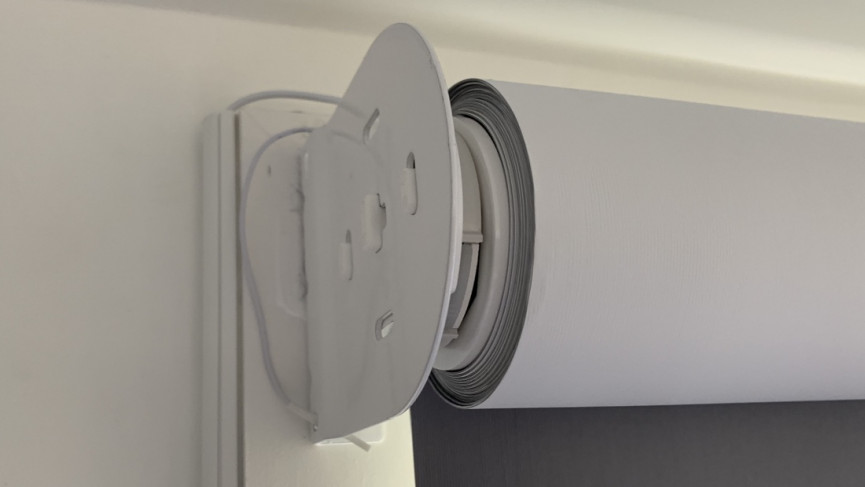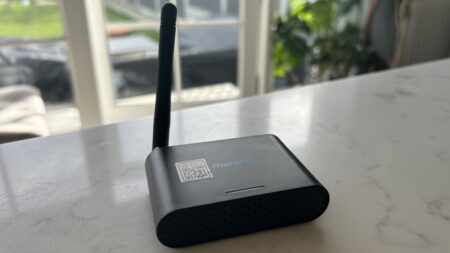Living with the Tahoma-powered Somfy Roll Up Wirefree
The Somfy-powered smart blinds experience is, overall, a good one. The blinds themselves - well, the motor powering them, at least - are superb quality, with a great motion and a vast array of radio controlled operating options. Alexa, Google Assistant and IFTTT add some much-needed smarts but you will have to rely on the, quite awful, Tahoma interface to get things going.
Pros
- Great quality
- Huge range of finishes
- Multiple control methods
- Easy to install
Cons
- Tahoma gateway is bad
- No HomeKit
- Quite pricey
- Alexa skill needs work
Before we go any further I should clarify that, while this review is indeed one of some Somfy-powered smart blinds – whopping great 3m ones that I’ve got fitted over the doors and windows in my garden office – Somfy doesn’t actually make the blinds (i.e. the fabric part) itself.
To be more specific, Somfy is a motorised motor specialist, allowing you to choose from hundreds of designs, sizes and materials from a large range of suppliers it has partnered with.
In my case, I’ve been testing the Somfy Roll Up Wirefree; a battery powered quiet drive motor, along with an all-in-one grey roller from Powered Blinds. Check out that link and you’ll see that they offer an absolute plethora of electric blinds powered by Somfy – roller, Roman, bi-fold, cellular and more – in hundreds of colours and finishes.
What I’m reviewing here, then, is Somfy’s motor – the cost of which varies wildly depending on what size and material you opt for. Mine, a large (about as big as you can get for a single roll blind), with a black-out material would cost around £250.
I’m reviewing the experience of living with some Somfy-powered blinds; how they tie into the whole Tahoma smart home system; and how they sync up with the rest of your connected abode.
Here goes…
Updated: The Google Assistant and Alexa skills have been vastly improved and this review has been updated to reflect that. It was first published in May 2019.

Somfy smart blinds: Installation
Bearing in mind that the blinds I installed with the Somfy motor inside are 3m long and are designed to go almost ceiling to floor, you’ll be reassured to know that, even on that high-end of effort and awkwardness, installation was a breeze.
You just measure up where they are to be mounted and simply screw in the brackets that come in the box; the roller part easily just pops in. And easily pops out again, when you’ve installed it back to front the first time around.
Our verdict: Control4 review
There is a bit of wiring that comes out of the motor-end, which is easily hidden behind the roll of material, but which you’ll have to be able to access when you need to charge the battery. I’ve had mine installed for about three months now – going up and down daily – and I haven’t had to charge yet. When you do though, it’s as simple as plugging a power chord into a little port at the end of that wiring.
Somfy smart blinds: In use
The motor is part of Somfy’s RTS (Radio Technology Somfy) range and, in theory, never really needs to be smart at all. There are a range of Somfy RTS controllers, including the likes of the Smoove 1, pictured below, that can be used to move the blinds up and down.
You’ll also get a basic up/down remote control boxed with the blinds and Somfy also has a raft of sensors that can be paired up to move the blinds – think movement, sunlight and so on.
However you decide to control the blinds – I’ll get onto the smart options soon – you’ll first have to calibrate them. This simply means choosing the ‘start’ and ‘stop’ points of a completed up or down cycle.

Mine were pretty good out of the box, but I just needed to do a little tweaking to get the lower point to align with the top of my skirting boards, rather than touching the floor.
The motion, as you’ll see in the video above, is super smooth and very quiet. A far cry from the noisy, slow retrofit Soma smart shades we recently reviewed.
Somfy smart blinds: Features and integrations
Where things get interesting is when you start controlling the blinds with connected apps and voice assistants.
On the former there is Somfy’s Tahoma app, which uses a Somfy Tahoma smart home hub to integrate your smart blinds into a connected setup. Now, the Tahoma system itself is an absolute mess – read my review to find out exactly what’s wrong with it.
The TLDR version is that setting up routines and scenarios within Tahoma is a shambles. The Tahoma app, without a heck of a lot of effort, becomes essentially a glorified version of that remote control that comes in the box; a digital version of something that can make the blinds go up and down.
However, throw Alexa and/or IFTTT into the mix and you’re away. When first tested Alexa was a chore as Tahoma devices weren’t ‘devices’ within the Alexa world and they didn’t support natural language. For example, rather than Alexa seeing the Somfy motorised blinds as a device, and saying, “Alexa, open the blinds”, you instead had to create a scenario in the Tahoma browser-interface, and then ask the Tahoma skill to carry out that scenario. For example, “Alexa, turn on open the blinds in the kitchen”.
However, the Alexa skill has been recently updated so as the blinds are now seen as a device and a simple open/close command works a treat, and it’s easier than ever to include opening or closing within automated routines.
I’ve got it so that when I say, “Alexa, I’m going to work” to the Echo Dot in my kitchen, my office blinds open alongside Alexa firing up my computer, speakers and the like at the same time.
Google Assistant has recently been added to the mix too and, unlike Alexa, the blinds were seen as a device off the bat, so it’s super easier to get your blinds open or shut.
IFTTT recipes can also be found to combine the movement with geolocation, sunrise/sunset, motion detection and a whole lot more.





